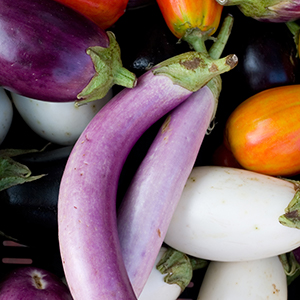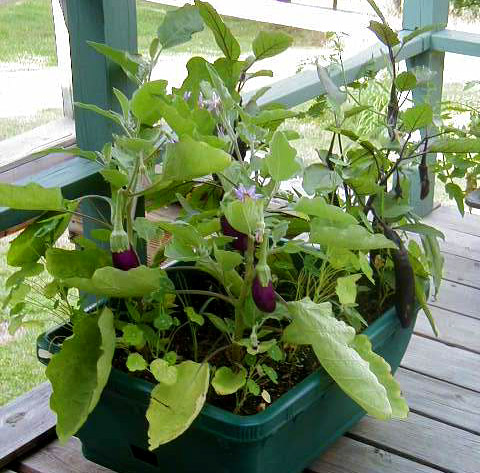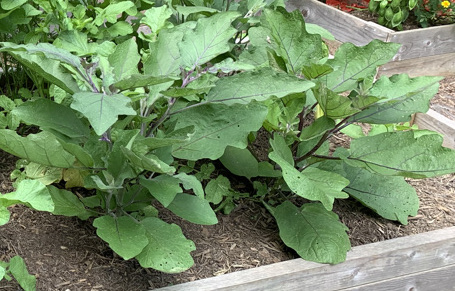Growing Eggplant in the Vegetable Garden
by Mark Kieffer, Fairfax Master Gardener
 If you’re looking for a plant that can handle our hot summers while providing color and a highly edible fruit, consider Solanum melongena, or eggplant. While not problem free, with proper care eggplant can be a prolific crop producing into the late summer.
If you’re looking for a plant that can handle our hot summers while providing color and a highly edible fruit, consider Solanum melongena, or eggplant. While not problem free, with proper care eggplant can be a prolific crop producing into the late summer.
Eggplant is a member of the nightshade family, or Solanaceae, that includes tomatoes, peppers and potatoes. In much of Europe, Solanum melongena is commonly referred to as Aubergine derived from the Arabic name for this fruit. The word “eggplant” is said to have been first recorded in the 18th century and was originally applied to small white cultivars, which look very much like hen’s eggs.
Although many think of eggplant as the large, dark purple ‘Black Beauty’ variety often seen in the produce section, there are many varieties with fruits in a variety of colors, sizes and shapes. For edible landscape gardeners, eggplant provides ornamental value with their glossy colorful fruit, attractive, purple-tinged green leaves and pretty violet flowers.

Eggplant can grow in containers
Before Starting
Make sure you have a spot with 8 to 10 hours of sun and well-drained, fertile soil. If your only space with full sun is a deck or patio, try growing eggplant in 5-gallon containers. If planting into an existing bed, do a soil test to determine if soil amendments are needed to adjust pH or to improve the nutrients and minerals for growing vegetables. If you grew other solanaceous crops in the past two to three years, rotate your planting. Don’t plant in the same bed every year, as insect pests common to Solanaceae overwinter and the soil harbors disease from prior crops. For container growing or in a new raised bed, you can use a good quality soil mix for vegetable growing available from the local garden center. If you aren’t able to test the soil in an existing bed, consult with a full service garden center or the VCE Helpdesk to get advice on soil preparation and fertilization.
Getting Started
If you plan to grow from seed, you should start them indoors under lights 8 to 10 weeks before the last average frost. Alternatively, you can purchase seedlings for transplanting. Full-service garden centers and mail order catalogs offer large selections of seeds and seedlings, including varieties for containers. In addition to information on seed packets and plant tags, seed supplier and extension service websites are good sources of detailed growing advice.
Seed starting indoors requires space and lighting along with care and attention to nurture healthy seedlings and to ensure successful transplanting and harvests months after the seeds first germinate. You can learn seed starting basics by reading on-line agricultural extension publications. Most guidelines for starting warm season vegetables from seed apply to eggplant. However, a tip for eggplant is to use bottom heat to maintain 80 to 90 degrees (26 – 32° C). The bottom heat should be removed after sprouts appear while maintaining temperatures around 70 degrees (21° C).
Transplanting
The most common transplanting mistake is planting seedlings outside too early as exposure to cold can permanently stunt eggplant’s growth and weaken defenses against pests and diseases. In addition, larger seedlings with 6 to 9 leaves and well-developed root systems will lead to better results and help the plant better handle pest pressure.

Eggplant foliage
Before transplanting, prepare the bed by adding soil amendments, including fertilizer, in amounts recommended by your soil test. Follow the instructions for amendments as the timing and amounts of applications can vary. If you purchased bagged container soil, read the product ingredients and instructions, as some soil mixtures include long lasting fertilizer reducing the need for fertilization at planting and later. In the absence of a soil test, a complete fertilizer such as 10-10-10 can be worked into the top couple of inches of the bed.
A week before transplanting to the garden, you should begin hardening off your seedlings, when outside temperatures are forecast to be consistently above 50 (10° C), to gradually expose the plants to sun and cooler air. Reduce watering and fertilization during this period and be ready to protect the seedlings if sudden cold temperatures occur.
Planting Out
Eggplant can be planted out two to three weeks after the last average frost date or when outdoor air and soil temperature are at least 70 (21° C). If temperatures are borderline or a dip is forecast, wait before risking cold damage.

Purple-tinged eggplant foliage
Generally, eggplant should be spaced 18 to 24 inches (45 – 60 cm) apart in rows and 30 to 36 inches (35 – 90 cm) between rows but consult the seed packet or plant tag for the specific variety. Proper spacing prevents crowding and allows air circulation, access for watering around the root zone and exposure to sunlight.
You can use cover cloth or caps to protect the tender seedlings from any unexpected cold. This type of protection can also be used to keep out insect pests to allow plants to become established.
Depending on the variety, small tomato cages or stakes are helpful to support plants as larger fruit varieties get heavy and cause stems to break or plants to fall over.
Care
Water seedlings well after transplanting. Mulch to maintain consistent soil moisture, conserve water and reduce weeds. Options for mulching include black plastic, compost, wood chips or low-growing green mulches such as Alyssum.
Continue watering, as needed, to maintain consistent moisture and reduce stress from dryness in the hot summer. Typically, 1 to 2 inches (2 – 4 cm) (per week is needed depending on rainfall. The critical period for soil moisture is during fruit set and fruit development.
Lower branches can be pruned both for air circulation and to encourage growth and productivity. You can pinch out terminal growth to reduce the number of fruit or allow all fruit to set but harvest when small.
Avoid overfertilization which can cause excessive foliage growth and slow flowering and productivity. Side dress with an all nitrogen fertilizer such as blood meal per manufacturer’s instructions four and eight weeks after planting. Place the fertilizer on the side of the plant and irrigate it into the soil.

Flea beetle damage
Problems
Flea beetles, eggplant’s most common insect pest, chew numerous, tiny holes in tender leaves, stunting growth and reducing productivity. Floating row covers can be used to protect tender seedlings from flea beetle damage. Larger plants can better handle flea beetle damage. Check frequently for flea beetles as severe infestations can be treated with Beauveria bassiana or spinosad. Please read the product label before applying these to your crops.
Eggplant is also susceptible to verticillium wilt. This can be reduced by planting resistant cultivars and crop rotation.
Radishes and basil can be used as companion plants to help with pest management. Radishes act as a trap plant by attracting flea beetles away from seedlings. Radishes can be sown in cool temperatures well before transplanting eggplant. Warm season basil plants can help deter hornworms and attract pollinators after blooming.

Chinese String, Long Purple, and Black Beauty eggplant
Harvesting
Eggplant should be ready for harvest 55 to 80 days after transplanting. Harvest when large enough to use but before the fruit loses its glossy texture and becomes tough and bitter. Some say they’re at their best when they’re still small. Use shears to pick as breaking off by hand will damage the plant. Pick regularly to encourage further production. Eggplant grows into late summer but productivity slows as it gets cooler.
Cultivars
There is a wide variety of cultivars to choose from. ‘Chinese String,’ an Asian variety, is a very slender, 10 to 15-inch long (25 – 30 cm) fruit with lavender-violet skin and white flesh. ‘Long Purple,’ another Asian variety, is 8 to 10 inches (30 – 25 cm) long, 2 inches wide (5 cm), cylindrical, but slightly wider at the bottom end, with purple skin and creamy white interior. The widely grown Italian variety, ‘Black Beauty,’ is 5 to 6-1/2 inches (12 – 15 cm) oblong, a 1 to 3 lb (0.5 – 1.5 kg) fruit with smooth, glossy purplish-black skin and off-white to tan interior.
References
Starting seeds indoors, University of Minnesota Extension
Growing Eggplant in a Home Garden, University of Maryland Extension
Eggplant Fact Sheet, Nancy Doubrava, Justin Ballew and Gilbert Miller, HGIC 1310, Clemson Cooperative Extension
Flea Beetles on Vegetables, University of Maryland Extension